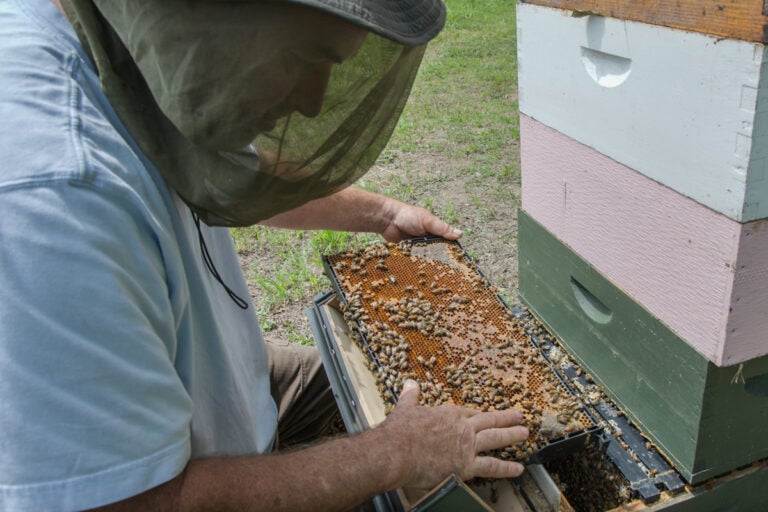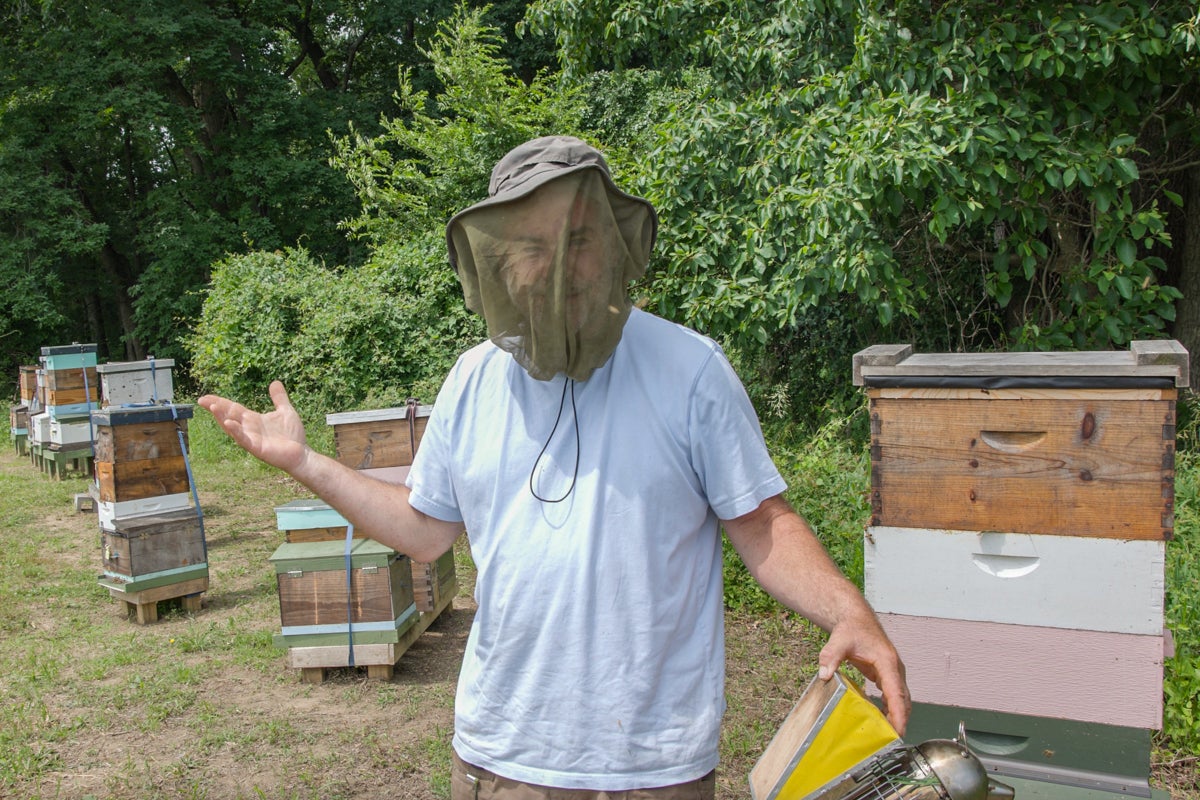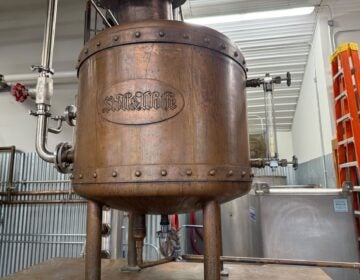A Delaware inventor wants you to consider raising bees
A unique hive design aims to reduce the physical demands on beekeepers while drastically improving colony survival rates.
Listen 1:23
George Datto, a beekeeper at the Winterthur Museum, sits on his stool inspecting the Keeper's Hive as he searches for the queen. (Kimberly Paynter/WHYY)
From Philly and the Pa. suburbs to South Jersey and Delaware, what would you like WHYY News to cover? Let us know!
The life of a beekeeper can be rewarding, yet challenging.
Early mornings often start with a visit to the apiary, where the hum of busy bees signals the start of another demanding day. Daily tasks include inspecting hives, checking the queen’s health, managing pests and harvesting sweet, gooey golden honey — all while enduring various weather conditions and avoiding stings. The true reward lies in the satisfaction of successfully nurturing a thriving colony.
It’s work George Datto is very familiar with. After 15 years of beekeeping, Datto has spent the last four years helping improve beekeeping efforts at Delaware’s Winterthur Museum, Garden and Library. Overseeing 10 hives at the museum’s apiary, he also educates visitors and sells locally sourced honey.
“Beekeeping is heavy, hot work. A gallon of honey weighs 12 pounds and a gallon of water weighs 8 pounds,” he described. “So just the typical challenges faced by all beekeepers, swarm prevention, [keeping] healthy hives and keeping hives alive.”

All that hard work could play a role in limiting the number of people willing to take on the tough task of beekeeping. But Datto’s been working on that problem. He’s developed a new hive designed to ease many of these challenges called the Keeper’s Hive.
The new hive design originated in 2016 when Datto and his team merged their expertise to develop the hive. They’ve been working over the past eight years to test and refine the hive to its optimal design.
Most hives in the U.S. are the Langstroth hive model, featuring stacked rectangular boxes with frames that can be removed one by one.
“It’s been the hive that most people use around the world, and it’s [a] very effective hive with the exception of requiring a lot of lifting to do management of the hive,” Datto said. “Therefore, oftentimes when used by the beekeeper, the management doesn’t get done because it requires a lot of lifting.”
Originating in the 1870s, the Langstroth hive was created by Philadelphian Lorenzo Lorraine Langstroth and has since become a standard worldwide. Beekeepers must lift and remove three to four heavy boxes per hive, each weighing between 30 to 80 pounds, to manage it properly.
Within a hive, there are two main sections: the brood chamber, where the queen and bees reside, and the honey box. Typically, the brood chamber is below and the honey box is above. Hence, beekeepers often have to move boxes to reach the brood chamber, essential for preventing swarms and diseases that could endanger the colony.
Its unique features and functionality
To make the work of beekeeping easier, “We’ve created a hive that you can manage your bees with less lifting,” Datto said.
Designed for today’s beekeepers, the new hive streamlines bee management and allows keepers to transfer existing frames and boxes to the Keeper’s Hive.
“The only thing that’s different about the Keeper’s Hive is the bottom box. You can get into the bottom box without removing all the boxes above,” he said. “All the frames, the boxes and everything that beekeepers are currently using with their Langstroth hive can work on the Keeper’s Hive.”
“One of the key features, believe it or not, is that you can sit down and work your bees. And it’s the only hive in the world where you’re actually able to pull up a stool, sit next to your hive and actually work the brood chamber,” he added.
There are three more noteworthy features.
“One, there is a hinge roof. The second feature is there is an observation window over the brood chamber, so as soon as you open that hinge roof, you can look through the observation window and get an idea of what’s going on in your brood chamber,” he said. “And then lastly, on the sides of the frames are these frame protectors that prevent the bees from propolis [a resin-like material made by bees], which is a major issue with getting frames out of a regular box.”
Extensively tested in Delaware and southeastern Pennsylvania, the new invention has received positive feedback. Beekeepers praise its reduced labor and report colony survival rates of 90 to 100%, significantly higher than the 50% with the Langstroth hive.
Keepers will have their first opportunity to place orders for the Keeper’s Hive when it officially launches June 11.

Saturdays just got more interesting.
WHYY is your source for fact-based, in-depth journalism and information. As a nonprofit organization, we rely on financial support from readers like you. Please give today.






